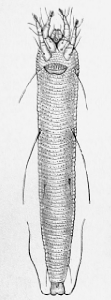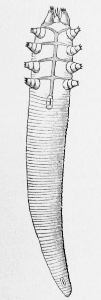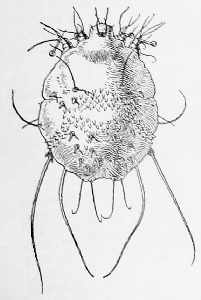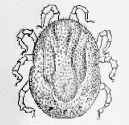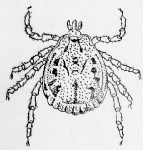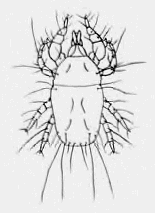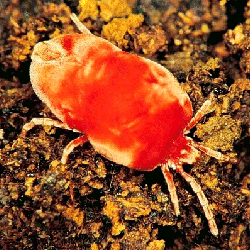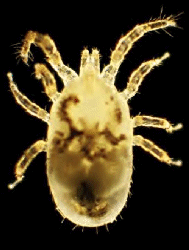INSECT FILES
Site Guide
Site Search
Home Page
Career Page
Insect Files
Shortcut to the main groups of insects and other arthropods...
Bug Rhymes & Poems
Links
Shop
Payments (credit/debit card)
|
Mites & Ticks |
Class: Arachnida
Order: Acari |
| Often too small to notice,
but sometimes with a big bite . . . . . . |
|
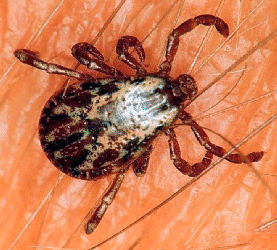
American Dog Tick - Male
(Dermacentor variabilis)
length 3-4 mm
Photo: J. Kalisch - UNL ©
|
Mites are distributed throughout the world, with over 30,000 species so far recorded.
The vast majority are tiny creatures less than one millimetre in length. The largest mites are the so
called 'ticks', most of which are around 3-10 mm long, like the American Dog Tick illustrated on the
left. The body of mites and ticks, in common with other arachnids (spiders, scorpions, etc.), is divided
into two regions - a front part called the cephalothorax (or prosoma) and a hind part called the abdomen
(or opisthosoma)- although frequently there is no clear demarcation or obvious constriction between these
parts (as found, for example, in the spiders) and superficially the body appears undivided. Most adult
mites and ticks possess the usual arachnid appendages, chelicerae (jaws) and palps (a pair of sensory
appendages) at the front-end, and four pairs of legs. However, in some specialised parasitic forms the
palps are more or less absent, and in one group of plant parasites, the Eriophyidae or gall mites, the
legs are reduced to two pairs. In their life-cycle and development from an egg to the mature adult, mites
and ticks pass through several stages, including a larval form with only three pairs of legs, followed by
a nymphal form with four pairs of legs like the adult. |
|
Mites are found almost everywhere in nature, on land and in water. Most are quite
harmless, living on dead and decaying organic matter or as predators of other small invertebrates, but
some are harmful by living as parasites on plants and animals. The parasitic forms include a number of
important pests of cultivated plants and several blood-sucking species that attack humans and other
warm-blooded animals. |
Pests of Cultivated Plants |
|
Red Spider Mites (family Tetranychidae)
Red spider mites are small, reddish coloured mites, up to about 1 mm long. Colonies develop on leaves and
other aerial parts of plants, often covering the foliage and stems with fine silk webbing. Young and adult
mites feed by extracting sap and cell contents from plant tissue, producing characteristic fine light mottling
and other discolouration. There are various species which attack many cultivated plants, both outdoors and
indoors. The Fruit Tree Red Spider Mite (which attacks apples, pears, plums and other related ornamental trees
and shrubs) and the Glasshouse Red Spider Mite (which attacks many house and greenhouse plants) are perhaps
the most troublesome pest species. See Buczachi & Harris (1998) for further details. |
|
Tarsonemid Mites (family Tarsonemidae)
Tarsomemid mites are very small, shiny cream-brown mites, usually less than 0.3 mm long. They generally feed
in buds, under leaf sheaths and in the tips of young shoots, and are therefore more difficult to detect than
the red spider mites, which feed openly on leaves. Effects on plants vary, but damage mostly results from mites
feeding on young tissues, causing reduced growth, distortion and even death of newly formed leaves and flowers.
There are various species which attack both outdoor and indoor plants, especially strawberries, cyclamens, asters,
chrysanthemums, azaleas, begonias, fuchsias and many other ornamentals. See Buczachi & Harris (1998) for further
details. |
|
Gall Mites (family Eriophyidae)
Gall mites are very small (more or less microscopic) mites, usually less than 0.2 mm long, with narrow, elongate,
white or yellow bodies and only two pairs of legs. The abdomen is transversely striated and appears segmented, but
these are just surface markings and not true body segments (see picture below). Adult and immature stages feed on
plant tissues, usually inside buds or in galls. The galls caused by some of these mites are often conspicuous, but
in most cases of little consequence to the future health and growth of the plant. The only real exceptions are the
Blackcurrent Gall Mite, which transmits the agent causing reversion disease of blackcurrents, and the Broom Gall
Mite, which may seriously affect the growth of cytisus (brooms) and genistas (gorses). See Buczachi & Harris (1998)
for further details. |
| <<< TOP |
Parasites of Mammals & Humans |
|
Mange Mites (family Demodicidae)
Mange mites are elongate, microscopic mites, similar in appearance to the gall mites (Eriophyidae), but with the
normal four pairs of legs. As with the gall mites, the abdomen is transversely striated and appears segmented, but
likewise these are just surface markings and not true body segments (see picture below). The mites live in the
hair-follicles of dogs and other mammals, including humans, and cause the disease called follicular or demodectic
mange. The commonest of these mites is a species called Demodex folliculorum, of which there are several
varieties, each specific to a different host. The variety that may be found in the hair-follicles and sebaceous
glands of humans does not usually cause any serious disease and often it has no ill effects at all. It has been
suggested that it causes the formation of 'blackheads' on the skin, but there is doubt about this. In contrast,
the variety which attacks dogs causes the serious disease called demodectic mange, which may take either the form
called scaly or red mange, where infected areas of the skin become reddened, scaly and wrinkled accompanied by
loss of hair and intense itching, or the so called pustular form, in which infection with bacteria occurs and
abscesses form. In either case the affected dogs acquire a repulsive smell and suffer greatly. |
|
Scabies or Itch Mites (family Sarcoptidae)
Scabies or itch mites are somewhat globular, semi-translucent mites, less than 0.3 mm long (see picture below),
that burrow into the substance of the skin. Itch mites, in all their active life-stages, have peculiar stalked
suckers on some of their legs which enable them to adhere to surfaces over which they walk. A variety of the
species Sarcoptes scabiei attacks humans and causes the skin condition known as scabies. Varieties of
this same species may also attack other mammals, including horses, cattle, sheep and pigs, causing the disease
called sarcoptic mange. Different varieties of the mite normally attack only the animal species to which they are
adapted, although very occasionally those that cause sarcoptic mange of animals may also attack the skin of humans
and live in it for a time. In this respect, the varieties that cause sarcoptic mange of horses and pigs, are
perhaps especially liable to establish themselves temporarily in the skin of humans and cause an annoying
dermatitis that may require treatment. The human variety of Sarcoptes is probably passed from one person
to another mainly by direct body contact. There is very little chance of transfer from clothing and bedding as
mites deposited in the environment die quickly and rarely present an infestation risk. The mites burrow and tunnel
into the skin using their chelicerae (or jaws) and also special cutting plates on the first two pairs of legs.
They cause inflammation of the skin and eventually the intense itching characteristic of scabies. The hands and
wrists are most often affected, but other parts of the body may be attacked. The first signs of the disease are
reddening of the skin followed by the erruption of spots to form a rash. Finally, the itching starts which
generally causes the sufferer to scratch. Scratching may aggravate the inflammation and may also liberate blood
and fluid from the skin which dries to form scabs. Bacteria may be introduced, so that septic sores may develop.
Itching may not begin for a month or longer after the mite infection is acquired. Hence, it is not caused by the
movement and tunneling activity of the mites, but probably develops as an allergic reaction caused by sensitization
of the infected person to the presence of mites. Under guidance from a doctor or pharmacist, scabies can be treated
by proprietary skin creams and liquids which kill the mites and alleviate the itching. See Mellanby (1972) for
further details. |
|
Velvet or Harvest Mites (family Trombidiidae)
There are several mite species belonging to the genus Trombicula (= Trombidium, see picture below)
that may annoy humans directly, especially during the late summer and autumn. Their larvae have various local names
such as harvest mites, harvest bugs, harvesters, berry bugs, bracken bugs, chiggers and, in Ireland, orange-tawneys.
The minute, reddish larvae of Trombicula, which are less than 0.5 mm long, suck the lymph and blood of humans
and other mammals. They puncture the skin and inject a substance that dissolves the skin tissue to form a kind of
feeding-tube. Their bites produce small spots which itch intensely and are often called 'heat-spots'. Dogs may be
considerably annoyed by these larvae, which attack them between the toes. When fully developed the larvae turn into
nymphs, which later become adult mites. Neither the nymphs nor the adults suck blood and both these more mature
stages are quite harmless. The larvae of some related tropical species of this same genus transmit to humans the
Rickettsia organism which causes the disease called mite-typhus (also known as scrub-typhus, tsutsu-gamushi
disease and Japanese river fever). |
|
Gamasid Mites (family Gamasidae)
This family includes several species of Gamasus that are well-known insect parasites. They are mostly pale
reddish-brown mites, up to about 1 mm long, with a smooth, shiny cuticle. Heavy infestations are found especially
on dung beetles, carrion beetles and on queen bumblebees. The mites are thought to suck fluid from their insect host
but this activity seems relatively harmless and many of them may be just 'hitching a ride' on the insect as it flies
from one place to another (click here for pictures of a carrion beetle infested with gamasid
mites). |
|
Hard or Shield Ticks (family Ixodidae)
Hard ticks are perhaps the more familiar ticks, possessing a hard scutum or shield, which lies over the front part
of the body of the female, but covers the whole body of the male (a typical hard tick, Dermacentor, is shown
at the top of this page; also see picture below). Most hard ticks are moderately large, with the
adults generally over 3 mm long and often much larger. They all live as external, blood-sucking parasites of reptiles,
birds or mammals. Many species, especially those that attack mammals, will also attack humans. In order to feed,
ticks bite through the skin and then insert the whole hypostome (the narrow, head-like front part of the body bearing
the mouth-parts) into the wound. They anchor the hypostome firmly into the skin by means of barbs on the chelicerae
(jaws), and because of this they can be difficult to remove. It is not advisable to pull a feeding tick off the skin
forcibly, since this often results in the mouthparts being torn away and left embedded in the skin. If this happens,
the embedded parts have to be removed surgically, otherwise the wound is likely to fester and cause further
complications. A simple way of removing a tick is to smear its body with some fatty substance, such as vaseline,
butter or oil, which blocks its respiratory organs. After a short time the tick should suffocate and come loose of
its own accord. Many of the hard ticks, especially those found in the tropics and sub-tropics, can transmit to humans
and other animals various bacteria, viruses and Richettsia organisms which cause diseases such as Asian spotted
fever, North American or Rocky Mountain spotted fever, American mountain fever or Colorado tick fever, Q fever, Russian
spring-summer encephalitis, human encephalitis and tick paralysis. |
|
Soft or Leathery Ticks (family Argasidae)
Soft ticks are similar to hard ticks in size and general appearance, but lack a hard scutum or shield (see picture
below). All the soft ticks are external, blood-sucking parasites of warm-blooded animals, including several species
that attack humans. They feed in much the same way as hard ticks (see above). Some tropical and sub-tropical species
can transmit dangerous pathogens to humans and other animals, such as the bacterial pathogen which causes relapsing
fever (also known as tick fever). |
| <<< TOP |
Other Pest Species |
|
Dust Mites (family Pyroglyphidae)
Dust mites are tiny, translucent mites, generally less than 0.2 mm long, and more or less invisible to the naked
eye (see picture below). They live amongst dust, feeding on the shed skin and other organic debris which constitutes
much of the 'dust' that settles and accumulates in our houses and workplaces. The mites themselves are quite harmless,
but their cast skins and the digestive secretions and enzymes they produce while feeding, and deposit in their droppings,
can cause severe asthma and other allergic complaints in humans. These mites probably occur in most houses and workplaces.
They sometimes reach huge numbers, although in many premises almost none are found. The degree of infestation depends on
general cleanliness - thorough and frequent vacuum cleaning (which in household premises should include bedding and
mattresses) can effectively reduce and contain mite infestations. In addition, it is equally important to maintain an
indoor environment that is unfavourable for the mites, in particular a low level of moisture and humidity - dry, well
aired buildings, with humidity levels below 60%, appear to support fewer mites than damp, musty premises. |
|
Food Mites (family Acaridae)
Several species of mites infest stored foods and other organic debris such as grain, flour, cereals, dried fruits and
vegetables, cheese, dried milk, ham, sugar, pet foods, paper, etc., and may also infest areas where moulds have formed,
as well as bird and animal nests. They generally prefer a moist, damp location. Sometimes the surface of infested
material may appear to move due to the enormous number of mites that are present. Also, a coating or small piles of
brownish 'mite dust', consisting of living and dead mites, cast skins and faeces, may appear on open shelving, around
the base of food packages, on the surface of cheese or in other foods where infestations have developed. The commonest
food mites are the grain mite (Acarus siro), the cheese mite (Tyrolichus casei) and the mould mite
(Tyrophagus putrescentiae). All are barely visible, usually less than 0.5 mm long, and more or less translucent
with darker mouthparts and appendages (see picture below). Prolonged contact with mite infested foods may produce a mild
dermatitis known as 'baker's itch' or 'grocer's itch', or cause asthma and dust allergies. Also, if mites are taken
internally by eating infested food, they may cause stomach disorders. Domestic control measures against food mites are
much the same as those for Meal & Flour Moths. Commercial control requires
professional fumigation. |
| <<< TOP |
References
- Buczachi S. & Harris K. 1998. Pests, Diseases & Disorders of Garden Plants. Collins Photoguide.
London (UK), HarperCollins.
- Mellanby K. 1972. Scabies. Second Edition. Hampton (UK), E W Classey.
- Walsh J. 2004. Photomicrographs of Dust Mites.
Micrographia (Sidney, Australia).
|

(classification of arachnids) |
|
<<< TOP |
(use the back button on your web browser to return to the previous page) |
TOP >>> |
|


